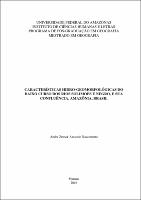| ???jsp.display-item.social.title??? |


|
Please use this identifier to cite or link to this item:
https://tede.ufam.edu.br/handle/tede/5289Full metadata record
| DC Field | Value | Language |
|---|---|---|
| dc.creator | Nascimento, André Zumak Azevedo | - |
| dc.creator.Lattes | http://lattes.cnpq.br/7723937378812412 | por |
| dc.contributor.advisor1 | Filizola Junior, Naziano Pantoja | - |
| dc.contributor.advisor1Lattes | http://lattes.cnpq.br/6356602589452935 | por |
| dc.date.issued | 2016-06-27 | - |
| dc.identifier.citation | NASCIMENTO, André Zumak Azevedo. Características hidro-geomorfológicas do baixo curso dos Rios Solimões e Negro, e sua confluência, Amazônia, Brasil. 2016. 63 f. Dissertação (Mestrado em Geografia) - Universidade Federal do Amazonas, Manaus, 2016. | por |
| dc.identifier.uri | http://tede.ufam.edu.br/handle/tede/5289 | - |
| dc.description.resumo | Os Rios Solimões e Negro são sistemas fluviais muito complexos que têm diferentes características. Tentar entender como interagem os processos hidrológicos, juntamente com a geomorfologia fluvial, é fundamental para a compreensão das mudanças que ocorrem na paisagem e no leito desses Rios. Por meio de dados batiméticos e hidrológicos foi possível extrair informações da morfologia do leito e hidrologia em trechos do baixo curso dos Rios Solimões e Negro, e respectiva confluência. O estudo possibilitou uma descrição dos processos e das características hidro-geomorfológicas que ocorrem na confluência dos Rios Solimões e Negro. O principal resultado foi a identificação de características da morfologia do leito e das zonas de fluxo encontradas nos estudos de confluências de grande rios. Uma possível região de fluxo uniforme no Rio Solimões, uma zona de fluxo uniforme no Rio Negro, uma zona de estagnação do fluxo na extremidade NE da Ilha da Xiborena, uma área de deflecção de fluxo, logo após uma região de altas velocidades, uma zona de separação do fluxo, áreas de recuperação do fluxo. E uma região onde ocorre um vale de erosão (bed scour) associado às regiões onde existe a deflexão do fluxo e também altas velocidades. Possivelmente, ocorre uma zona de deposição em barra submersa, após a junção dos dois canais. As transformações que ocorreram tanto nas margens da Ilha da Xiborena na extremidade NE, são tão notáveis que houve um aumento de área depositada, como na Ilha do Careiro na margem paralela ao Rio Solimões e da Ilha da Xiborena, onde houve uma grande erosão, ocasionado uma perda de aproximadamente 800 metros de terras. | por |
| dc.description.abstract | The Solimões and Negro are very complex river systems, which have different characteristics. Try to understand how they interact hydrological processes along with the fluvial geomorphology is fundamental to understanding the changes that occur in the landscape and in the bed of these rivers. Through bathymetry and hydrological data it was possible to extract information from the morphology and hydrology of the bed in the lower course of the Solimões and Negro sections, and their respective confluence. The study made possible a description of the processes and hydro-geomorphological characteristics that occur at the confluence of the Solimões and Negro, the main result of the identification of the bed morphology characteristics and flow zones found in the confluences studies of large rivers. A possible uniform flow region before confluence in Solimões River, a uniform flow area in the Black River before confluence, there is a flow stagnation zone in the NE end of the island of Xiborena, an area for flow deflection, shortly after high speed region, and a separation zone of the flow at the end there is the recovery zone flow. A region where an erosion valley occurs, associated with regions where there are the deflection of the flow, and also high speeds. Possibly it occurs in a deposition zone submerged bar, after the junction of two channels. Are remarkable transformations that occurred both on the banks of Xiborena Island in the NE direction end, which had a deposited area increase, as in Careiro Island in parallel edge to the Solimões River and the Island Xiborena where there was a great erosion, caused one loss of approximately 800 meters of land. | eng |
| dc.description.sponsorship | CAPES - Coordenação de Aperfeiçoamento de Pessoal de Nível Superior | por |
| dc.format | application/pdf | * |
| dc.thumbnail.url | http://tede.ufam.edu.br//retrieve/14119/Disserta%c3%a7%c3%a3o%20-%20Andr%c3%a9%20Z.%20A.%20Nascimento.pdf.jpg | * |
| dc.language | por | por |
| dc.publisher | Universidade Federal do Amazonas | por |
| dc.publisher.department | Instituto de Ciências Humanas e Letras | por |
| dc.publisher.country | Brasil | por |
| dc.publisher.initials | UFAM | por |
| dc.publisher.program | Programa de Pós-graduação em Geografia | por |
| dc.rights | Acesso Aberto | por |
| dc.subject | Hidrologia | por |
| dc.subject | Geomorfologia | por |
| dc.subject | Morfologia do leito | por |
| dc.subject | Rio Negro - AM | por |
| dc.subject | Rio Solimões - AM | por |
| dc.subject | Hydrology | por |
| dc.subject | Geomorphology | por |
| dc.subject | Geomorfologia Fluvial | por |
| dc.subject | Ecobatimetria Monofeixe | por |
| dc.subject.cnpq | CIÊNCIAS HUMANAS: GEOGRAFIA | por |
| dc.title | Características hidro-geomorfológicas do baixo curso dos Rios Solimões e Negro, e sua confluência, Amazônia, Brasil | por |
| dc.type | Dissertação | por |
| Appears in Collections: | Mestrado em Geografia | |
Files in This Item:
| File | Description | Size | Format | |
|---|---|---|---|---|
| Dissertação - André Z. A. Nascimento.pdf | 4.56 MB | Adobe PDF |  Download/Open Preview |
Items in DSpace are protected by copyright, with all rights reserved, unless otherwise indicated.




